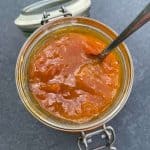Apricot & Vanilla Bean Jam
Make the most out of seasonal apricots with this apricot & vanilla bean jam. This stuff's super easy to make & contains a whole vanilla bean!
Servings: 1 Large Jar
Equipment
- Digital Food Probe
- Large Kilner Jar
- Large Mixing Bowl
- Large Saucepan
- Juicer
Ingredients
- 1 kg Fresh Apricots (Prepared Weight - See Notes)
- 750 g Caster Sugar
- 1 Vanilla Pod
- 2 tbsp Lemon Juice
- 30 g Unsalted Butter
- ¼ tsp Sea Salt
Instructions
Macerating
- Cut each apricot in half & remove the stones.
- Place the fruit into a large mixing bowl with the sugar, vanilla & lemon juice. Give everything a good mix then cover the bowl with clingfilm & refrigerate overnight.Scrape the seeds out of the vanilla pod & add both the pod & seeds to the apricots. Let the fruit macerate for at least 12 hours or up to 24.
Cooking
- Transfer the contents of the mixing bowl into a large saucepan then set over a low heat. Cook, stirring regularly until the sugar has dissolved & the apricots are soft & have started to break down. This will take 10-15 minutes.
- Next, turn the heat up to medium-high, bring the jam to the boil then cook, stirring occasionally until the temperature of the jam reaches 105°c/221°f.You'll need a food probe here!
- Take the pan off the heat then stir in the butter & a pinch of sea salt. Leave to cool slightly then transfer the jam to a sterilised jar.
Notes
1. Cooking On An Aga – Cook the jam on the simmering plate to dissolve the sugar then move over to the boiling plate to boil.
2. Wrinkle Test – If you haven’t got a digital food probe, you can use the wrinkle test to check if your jam is cooked. To do this, place a small plate/saucer into the freezer before making your jam. Then to check, spoon a small amount of jam onto the cold plate, leave it for 1 minute then drag a finger through it. If it wrinkles, it’s ready. If it doesn’t, keep cooking for a few more minutes.Using this method, I find that it’s best to check the jam after 4-5 minutes of boiling. Make sure to take the jam off the heat whilst you check it, so that it doesn’t overcook.
3. Storage – Kept in the fridge, in a sterilised jar, this jam will keep for several months. To sterilise jars, I like to follow the instructions over on the Kilner Jar Website
4. Apricots - For this jam recipe, you'll need 1 kg of prepared apricots (with the stones removed). Make sure to use fresh apricots that are just ripe. If they need a clean, give them a quick rinse under cold water.
5. Butter - Stirring butter into the cooked jam removes any foam, giving the jam a cleaner, glossier finish. If you're using salted butter, add half the amount of sea salt.
